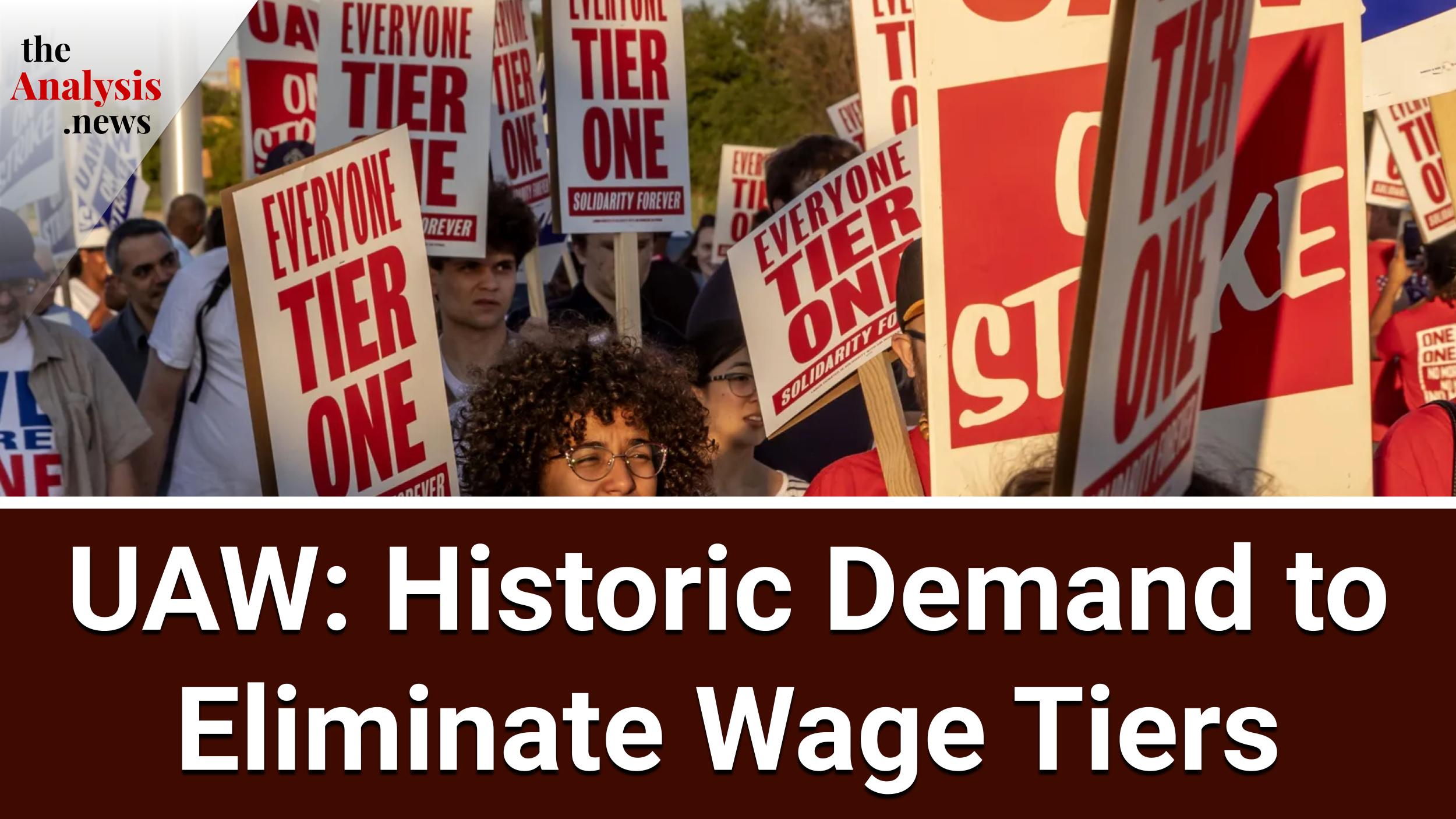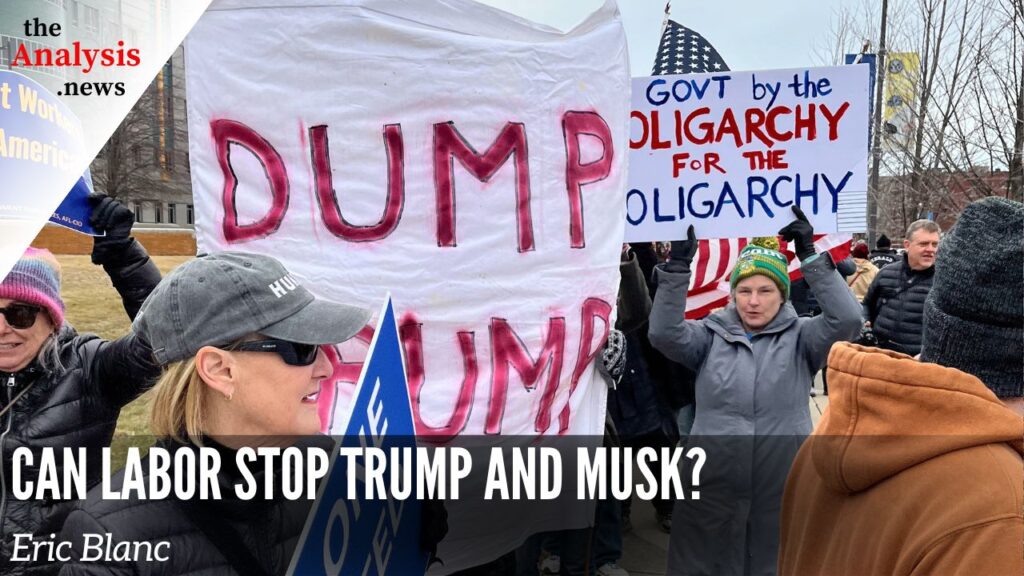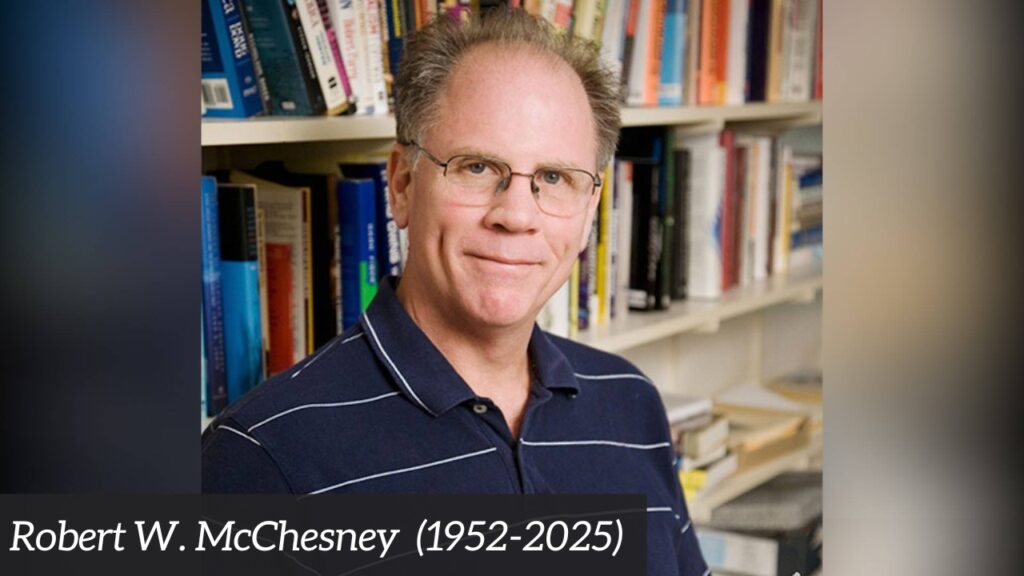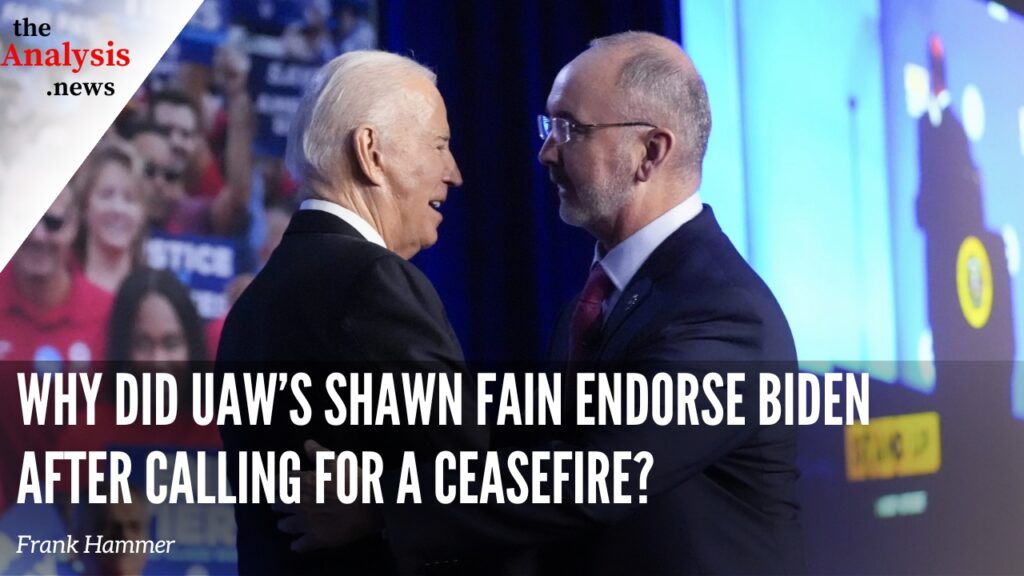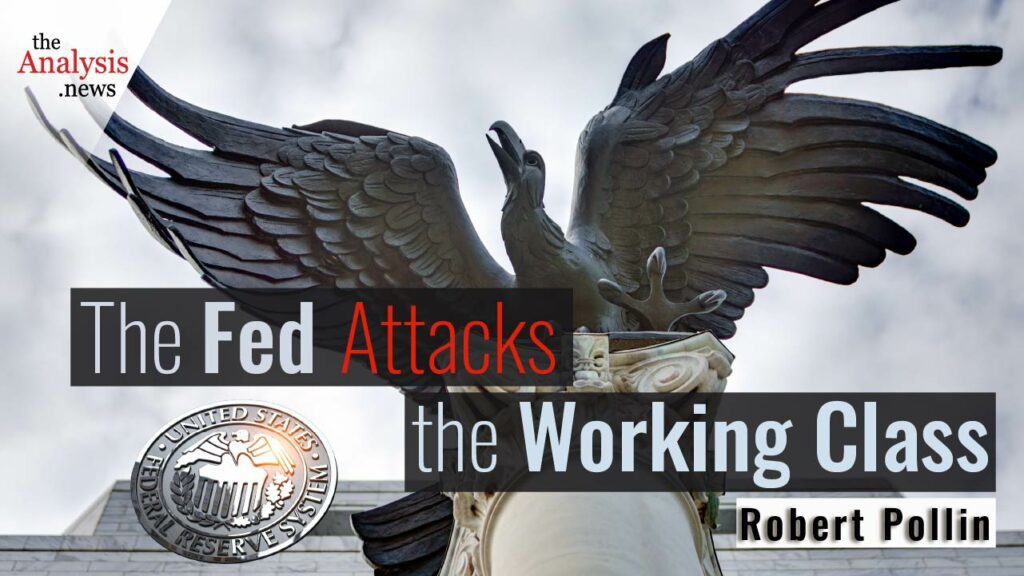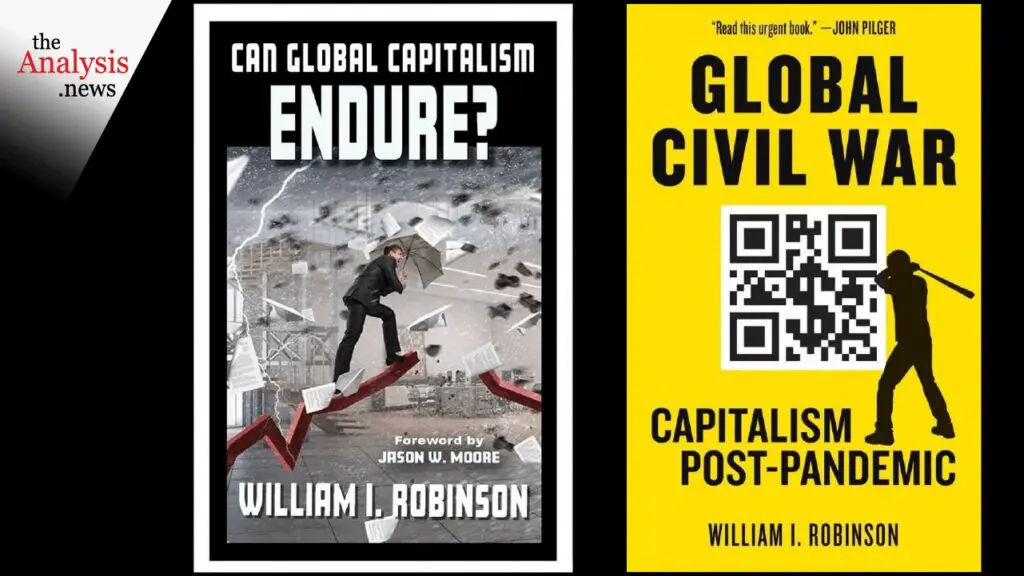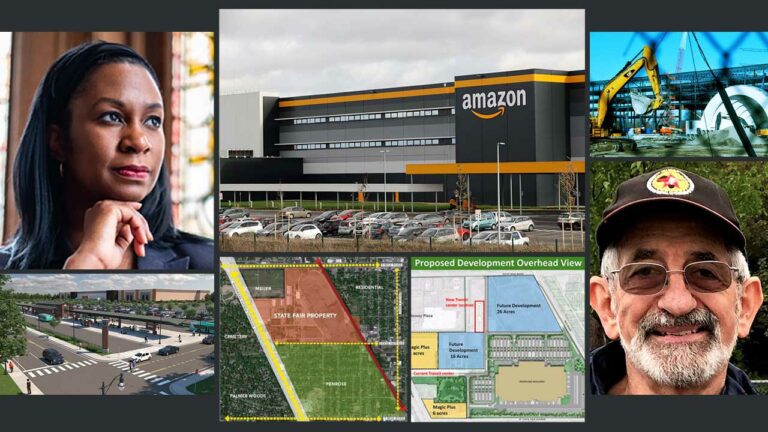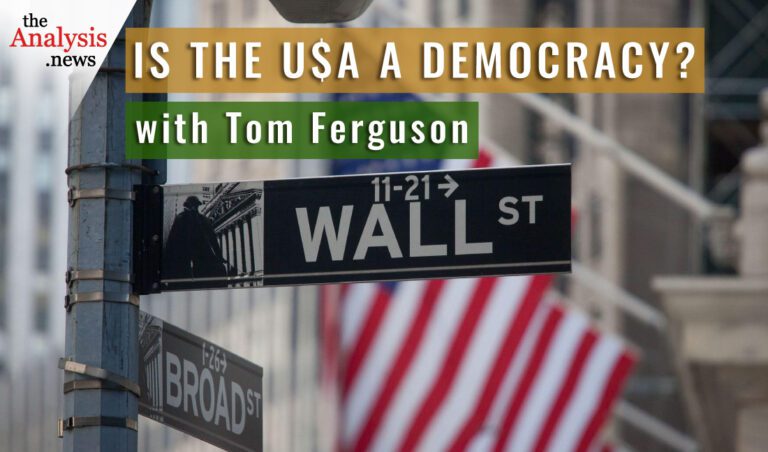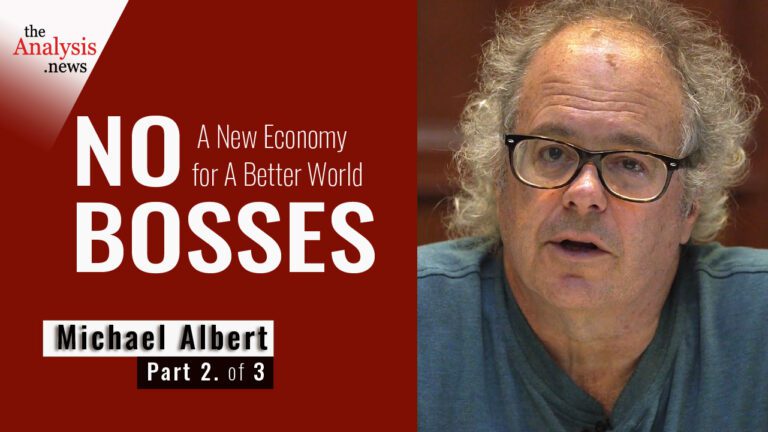Frank Hammer, former President of United Auto Workers (UAW) local 909 in Detroit and retired GM worker, explains how “legacy” workers are standing up for new hires. This is critical to building working-class solidarity. He also reflects on the history of autoworker strikes in the U.S. and in Mexico, reminding us of the deadly incident at the Ford Cuautitlán plant, in which thugs dressed in Ford uniforms shot dead one of the workers and injured ten others.
Talia Baroncelli
Hi, I’m Talia Baroncelli, and you’re watching theAnalysis.news. Joining me in a bit is Frank Hammer, who is the former president and chairman of the UAW local 909 in Detroit. We’ll be speaking about the UAW strike and the twists and turns in the strategy of this really historic stand-up strike. Before we get to it, it would be great if you could go to our website, theAnalysis.news, and give a small donation if you can by hitting the donate button at the top right corner of the screen. You can also get onto our mailing list; that way, you’re updated every time a new episode is released. Subscribe and like our podcast on whichever platform you watch the show on, as well as on YouTube, theAnalysis-news. See you in a bit with Frank Hammer.
Joining me now is Frank Hammer. He’s the former president and chairman of the United Auto Workers local 909, which is located at the GM transmissions plant in Detroit. He’s a former GM worker and worked for GM for 32 years. So it’s really great to have you today, Frank.
Frank Hammer
Great to be with you. Thank you.
Talia Baroncelli
Last week, on September 15, we saw 12,700 United Auto Workers participate in a stand-up strike. They walked out at plants in Toledo, Ohio, Wayne, Michigan, and Wentzville, Missouri. Today, Shawn Fain, who is the current president of the UAW, announced that there would be an additional 38 strikes at plants across 20 different states.
Why don’t we speak about the historic strategy that’s being employed by having these targeted strikes? First, I think it’s important to discuss what’s really at stake here, what the UAW is calling for, and whether you think the big three automakers, GM, Ford, and Stellantis, will meet the workers’ demands.
Frank Hammer
To clarify, I think it’s got the whole UAW membership and way beyond very excited. It’s not 38 plants; it’s 38 parts and distribution centers or parts distribution warehouses. The difference is, of course, there’s no production in those facilities, by and large. This is where, as I said, it’s parts distribution. It’s more like a logistics warehouse, but it’s very key to the distribution of parts throughout the whole system. This is at GM. This is at Stellantis. This is currently not at Ford because Shawn Fain reported that there was progress at the negotiating table with Ford.
Talia Baroncelli
That’s correct. What do you think we can expect right now from the ongoing negotiations between UAW, Ford, Stellantis, and GM?
Frank Hammer
Well, I think what’s really striking to me, and I’ve been in the labor movement for 50 years, is that the UAW has really had the upper hand in these negotiations and certainly the upper hand in terms of its media and the message. I think that this has gotten these three big, large megacorporations set back on their feet because they do not know how to cope and deal with this. Never mind the media strategy, the strategy of actually taking out plants in all three companies and taking them out in this measured selective way, keeping the companies guessing, is really quite profound. I don’t think the companies have found themselves in this situation in decades, and they’re grasping to figure out what to do. I think that’s a good place for the UAW to be. It’s having an impact not only on the UAW but on many workers. The UAW has said, “We’re fighting for the whole working class.”
Talia Baroncelli
Why do you think Shawn Fain decided to use this stand-up tactic? Is it because it’s taking the “Big Three” off guard? Does it have this surprise element where they don’t really know what to expect and which distribution centers or plants are going to go on strike? Is it trying to recreate the sit-down strikes from 1937?
Frank Hammer
Shawn Fain has certainly compared this tactic of the strategy now to the workers’ struggle to get union recognition in the ’30s. Of course, then, they were sit-ins, and these today are stand-ups. They tried to be strategic as they were in the Flint sit-downs: striking, occupying, and sitting in on an engine plant, which paralyzed General Motors.
At that time, GM was the largest company in the world and very anti-union. It forced GM to recognize the UAW. We’re in that kind of moment, I think, is what Shawn Fain is communicating. I think that they’re taking a measured approach. They don’t want to deplete the strike fund. They want to give the companies an opportunity to change their ways and come across with proposals that the UAW can accept. My take is that a majority of workers are really enthusiastic about the approach that he has taken.
Talia Baroncelli
I think a lot of people realize how important this strike is, and they see the connections between the cause and the purpose of this strike and how it’s tied to the labor movement in general. I get the sense that a lot of people are really supporting the UAW here.
What are the core issues that the UAW is pressing on? My interpretation is that the main issue is getting rid of the tiered system. Some workers start working at $15 an hour, and they have to work 20 years before they can make it to the top before they can earn more money and get benefits. Some don’t even have COLA (Cost of Living Allowances). What else is at stake here? What is the platform of the UAW right now?
Frank Hammer
Well, I think that you’re emphasizing certainly one of the very core demands that the UAW has put on the “Big Three.” This matter of tiers, this matter of workers occupying different castes; it’s a caste system within the companies. This is what workers have been forced to grapple with.
It began in 2003 after GM, Ford, and Stellantis all shed their parts operations into standalone companies like Visteon and Delphi. They came back and negotiated a whole new tier at those companies for workers who had not yet even been hired. Fast forward to 2007, they began to institute that at the “Big Three.”
I can tell you what, and I know what the argument was then. I think it’s important for people to know. The companies told the UAW, we’re either going to outsource all this work to non-union plants, and you can decide to try to organize them, or we’ll keep them in-house. You’ll still get your dues, you’ll be able to represent them, but they’re going to come in at a lower wage with lower benefits. The UAW unfortunately agreed, and then this was locked in during the bailout.
What we have today is four or five tiers. You have the temps or supplemental workers. You have the new hires. You talked about the progression; they often had to go eight years to make their ultimate wage. You have subcontractors initiated by GM. GM has subsystems. They have a separate contract with lower wages. By the way, not one worker at the “Big Three” has COLA, not even the legacy workers, that was suspended during the bailout. The term suspended, I guess, was used very loosely because here we are 13 years later, and we don’t have COLA, and that’s for everybody, including retirees, by the way. We don’t have it for any active worker. You touched on one of the most heartfelt issues that has to be done away with. Workers have to enjoy the right to equal pay for equal work, which is embedded in the Universal Declaration of Human Rights that the U.S. government is a signatory to.
Talia Baroncelli
Well, let’s give some more context to the bailouts. In 2008, I remember at the time, it was a huge deal. The U.S. government was bailing out the “Big Three.” The bailouts in the U.S. and Canada amounted to something like $85 billion (USD) across the auto industry. It was a lot of money. At the time, the “Big Three” were saying that they needed this money so that they could ensure that people would still have jobs. They obviously cut a lot of those jobs, but some people would still be able to hold onto their jobs. At the time, getting rid of COLA and instituting or continuing this tiered system was presented as a temporary measure or was it presented as the gravy train is over and you’re going to have to deal with this for the next few decades?
Frank Hammer
It was the former. The common understanding, which has been repeated over and over in various kinds of media, even in alternative media, is that this was a temporary setback for auto workers that, in the goodness of their hearts, they sacrificed. Now that the companies are back on their feet, we’re back to get ours, which we gave up. That is, unfortunately, a myth. It was not about making promises to return what was given. It was an actual restructuring.
The czar of the Auto Restructuring Committee that was set up under Obama, the book that he wrote is Overhaul. It’s called Overhaul. It was meant as a permanent restructuring of auto. It was in line with what Naomi Klein has written about so eloquently. It’s about something called a shock doctrine or disaster capitalism. This was one of the prime examples of where we have this bankruptcy. The market fell from 17 million cars all of a sudden to 10 million, and we have a shock to the system. Wall Street and the auto companies seize the moment and say, “We can take advantage of this and lower and restructure what auto workers are going to get compensated going forward.” They did a hell of a job. This was under George Bush, and this was under Barack Obama, and by the way, with Biden as well.
Talia Baroncelli
Did this accelerate the offshoring of a lot of these manufacturing jobs, or was that already underway from the early 2000s?
Frank Hammer
The offshoring of jobs, I can tell you there have been different places along the way where offshoring has been salient, but it goes back to the ’70s. It goes back to the ’80s. It goes back to the ’90s with NAFTA. It goes back to 2005. I remember being in a room when General Motors announced that if you’re a supplier and you’re not based in China, we’re not doing business with you. The offshoring has been this constant stream of threats and loss to the U.S. auto workers. The bailout didn’t stop the offshoring. It went on, and it went on.
We have today in negotiations, Stellantis going on and saying, “If you keep this up, we’re going to send more truck manufacturing to Mexico.” So it’s been constant. The bailout, you would think, okay, workers made all these sacrifices. Good, we’ll keep more jobs. It didn’t happen.
Talia Baroncelli
That’s interesting that you point out that there is also a bit of misinformation, even in the alternative media, because that’s definitely something I’ve heard. During the bailout, workers made those concessions thinking this was a temporary measure. We’ll have to give up COLA, and we’ll have to live with these cuts, but eventually they’ll be reinstated. So that’s very interesting that, at the time, it was basically a restructuring in accordance with what had been instituted previously in post-Fordist models where work was getting even more precarious, and people weren’t able to rely on benefits. So that’s really fascinating, and that kind of takes me to additional, I would say, propaganda almost.
When you listen to the CEOs of some of these companies, such as Jim Farley, the CEO of Ford, there was an interview with him recently in which he said that if Ford were to respect the demands of the UAW, they would go bankrupt. He was basically saying that they would have to pay out something like $300,000 per worker a year if they were to respect or follow through with these demands. But that is, in effect, not true because the demand of $300,000 a year is based on the absolute highest tier. If you were to monetize all of the benefits that workers would be entitled to, it would only be a fraction of the auto worker population. So that is just pure lies to say that this is what the workers are really demanding. In addition to that, the automakers have been making huge profits. Within the first six months of 2023, the “Big Three” reported that they made something like $21 billion in profits. So it’s just not true that they can’t meet the demands of the workers.
Frank Hammer
Yeah, and I thoroughly agree with what you just said. I would add that Shawn Fain pointed out that the labor cost for auto companies is 5% for the production of a vehicle. I think that you could look back at the bailout, and you could look back at negotiations. In the middle of negotiations, there’s always a threat, “Oh, this is really bad for the industry, and we won’t be competitive.” These are ways to shape the narrative and try to win the public. The workers are demanding too much, and this is outlandish, and so on. But I think that these are more for media communications than reality. They use that justification for everything. They use that justification to send all of our work to Mexico. Oh, we can be more competitive. Well, they’re making out like bandits, and that’s what the UAW is saying. At some point, we have to stop the banditry and reach equity for the workers and working-class people.
Talia Baroncelli
Yeah, they’re saying they need to be more competitive. But in the past year, they’ve also spent over 5 billion in stock buybacks to increase demand for shares and to drive up the share values. They clearly have money, and the CEOs have been pocketing all sorts of big profits.
Why don’t we speak about Mexico? I’m not so familiar with the struggle there, but I know there were incidents in the early 2000s. I believe there was a very tragic incident in Mexico at one of the plants there. I think the conditions for workers in Mexico have also been pretty terrible.
Frank Hammer
I am so glad you brought up Mexico. By the way, today, Shawn Fain, in a statement in his livestream, mentioned that there have been expressions of international solidarity all over the world, including from Mexico. We can go back, depending on how far back in history, but I can tell you that, for example, in 1890, auto workers in a quasi-line assembly plant for Ford waged a militant struggle against a corrupt union, a pro-company union controlled by the government. Their fight, which included the occupation of their factory, they had between Ford and there was also some AFL-CIO involvement, 300 goons armed with machine guns and battering rams. They entered the factory and shot nine of the workers. One was killed. Those are the kinds of conditions that were faced by Ford workers.
We fast forward to 2019, a different scenario. This was the GM assembly plant in Silao, where they manufacture trucks and, again, workers militancy. Some of the workers started to refuse overtime, mandatory overtime, and started to fight against speed up in support of our strike here at GM, where we had a 40-day strike among many of the same issues that we’re fighting for now. Those workers were fired. They kicked out the corrupt union that was in control, and they formed their own independent union. They get paid a 10th of what U.S. workers get paid. They did negotiate a contract. They did get some raises. But they need a lot of support from U.S. workers to raise their level to a livable life and livable wage in the same way that we’re fighting here for the same.
Talia Baroncelli
Do you think the “Big Three” are scared that the amount of support behind the UAW in the U.S. and the scale of the strikes will inspire workers in Mexico to also go on strike?
Frank Hammer
It’s already happening.
Talia Baroncelli
It’s already happening.
Frank Hammer
It’s already happening. I’m happy to report that there are a growing number of UAW members and supporters who want to support and aid workers in Mexico who are also waging this fight. In fact, one of the leaders of this GM situation in 2019 will be in Detroit this weekend, and he will be meeting up with UAW workers. They’re going to be trading notes and comparing their life experiences and their work experiences. I see this growing. Not only in Mexico, but I heard of Canadian workers who have been very inspired by Shawn Fain’s live streams and so on. There are a lot of workers that are looking from different countries and see what’s going on down here in the U.S. I really respect Shawn Fain for the burden that he’s taken on and providing this new leadership for the UAW.
Talia Baroncelli
Well, that’s great to hear. What do you make of the domestic politics in the U.S. at the moment? Trump has obviously taken advantage of the strike, and he’s trying to position himself as someone who is pro auto worker. But he has a pretty bad track record. Maybe you could speak about his track record. He’s said that he’s going to go to Detroit next week on September 27 to make an appearance. So far, the Biden administration hasn’t really said that they’re going. The spokesperson, Karine Jean-Pierre, hasn’t confirmed or denied that Biden would be making an appearance in Detroit. So it seems like the Biden administration has been caught with the tail between their legs, so to speak. It’s kind of a sad state of affairs, but maybe they’re just completely intimidated by Shawn Fain’s amazing leadership.
Frank Hammer
Surely, Biden would have done himself a favor by doing as Bernie Sanders did, which was he came to Detroit. Bernie Sanders came and addressed a rally of 700 auto workers and supporters right in the lead-up to the strike. I think Biden would have been able to do that, could have done that, and could still do that. Unfortunately, he’s compromised because he was part of the deal of the restructuring. Now, he’s in a position of having to reverse himself. In the eyes of Wall Street, that doesn’t work. You made a deal, and you’re going to stick with it. I think that’s why you haven’t seen Biden.
If I was asked, well, what could Biden do for negotiations? He could go about the business of talking about raising the minimum wage and leading a movement in this country. We have not had a raise in the minimum wage in 14 years. It doesn’t matter whether it’s under Bush, Obama, Trump, or Biden. It’s clear that the entire class of capitalists is quite satisfied with the state of affairs. They are holding us down and, at the same time, encouraging us. I saw comments from Obama and Biden encouraging our current strike, but as long as you got your foot down on what the minimum wage is, it’s kind of hard to go against that. I think that’s what we need. We need a campaign that truly raises the minimum wage after 14 years, certainly in the face of all the inflation that we’ve been enduring post-pandemic.
Talia Baroncelli
Yeah, Biden just let the parliamentarian decide on that one. He didn’t really seem to care so much about increasing the minimum wage for whatever reason. He was in a position to actually do something, and he didn’t, which is pretty regrettable. In the current state of affairs, my sense is that people who are out striking have a lot of energy and motivation, but they may be a bit pessimistic as to the result of all of their efforts.
You grew up being active in the ’60s. I would say that particular decade of the 60s was very– what’s the word to use? It was such a turbulent time. I obviously wasn’t around, so I can’t speak from experience, but it was a turbulent time. It was also very inspiring to see all these different movements and people out on the street. I wonder what your sense is in comparing the current movements today for the climate, whether it be movements such as Extinction Rebellion, the Last Generation, or the UAW movement, compared to a lot of the movements that were going on at the time that you were also involved in, and whether you feel that there’s more of a sense of pessimism now compared to back then.
Frank Hammer
I’m happy to answer your question, but I don’t want to let Trump off the hook.
Talia Baroncelli
That’s right, we didn’t get to Trump. Let’s start with Trump first, and then we’ll get back to it.
Frank Hammer
I think this is very important because now we have Trump fishing in troubled waters by coming to Michigan, I think, this coming Wednesday. I think he’s dumb as a rock. What he’s done has now attacked the UAW leader who is standing up to the billionaires, Shawn Fain. He thinks that by attacking Shawn Fain, he’s going to make inroads into the UAW. I think he’s going to be sadly mistaken.
On the contrary, it’s very important because there was always this notion that there were a lot of auto workers who supported Trump in 2016, many of them who had supported Bernie Sanders before that. I think it’s very important to explain how Trump sells this snake oil. I want to quote from a Detroit news article that was published in 2015, which said, “Trump suggested…” this is right before he ran for election, “… one way to stop automakers expansion to Mexico is by moving some production out of Michigan to lower-wage states.” He didn’t have a problem with shaming UAW members. In fact, he said, “U.S. automakers could shift production away from Michigan to communities where auto workers would make less.” You can go to different parts of the United States, and then ultimately, you go full circle. You’ll come back to Michigan because those guys are going to want their jobs back, even if it is less. That’s Trump’s strategy. In fact, that’s been the strategy of the whole capitalist class. He’s spelling that out. If anybody thinks that that’s worker-friendly, you should go back and read the article because it’s hostile to our membership. Here he is coming, thinking he is currying favor with us. It’s not going to work. He’s a charlatan. He’s trying to fool auto workers into thinking that he’s their buddy. He’s not. He’s their enemy.
Now, to go to your question. The movement in the ’60s– revolution was in the air. In Detroit, we had the League of Revolutionary Black Workers who were shutting down plants, demanding rights for black workers in the UAW and in the industry. There was all this sermon: the anti-war movement, the civil rights movement, but there was a level of activity that compelled a lot of us to become activists for a long time.
Today, you begin to see this in different instances, especially in the environmental movement. I noticed that the media, mass media, and corporate media did not report on the massive demonstration in New York City. I think it was last Sunday. There was not a peep. Not a peep. Not even on so-called liberal corporate media. I think there were demonstrations in many, many other places. This is a sign of a rising movement, certainly among young people who are confronted with the existential threat of what climate catastrophe is going to look like to me or to parents with young children. I think that there is no way around having to build that kind of movement.
I’m glad to see that there’s an increasing harmony or homogenizing of interest between the global and climate catastrophe movement and the UAW. We had over 100 organizations that are espousing climate change as an issue or social justice issues who’ve come out in support of the UAW strike, especially in the demand for a just transition. Now that the UAW is confronted with all the electrification of the industry and battery production in non-union plants. I have to say, having been active 50 years in the labor movement, that is the kind of excitement that I’m seeing in the working class, seeing at this rally where Bernie came, and Rashida Tlaib and so on. To see the level of excitement, anger, and hope is really refreshing. I think that this is a wake-up going on in the working class movement. I think that people should have some enthusiasm about where the direction of this movement is going to go.
Talia Baroncelli
Well, you bring up an important point, and that’s the issue of electric vehicles. I think the Inflation Reduction Act had provisions in there to support the electric vehicle industry at something like $9 billion worth of loans. The UAW workers are not saying that they don’t want this just transition to electric vehicles, but what they’re concerned about is that they won’t have union jobs in electric vehicle plants. They want to ensure that the current levels of employment are maintained and that money is invested in this just transition because you can’t just have a green transition without actually subsidizing it and paying for it and ensuring that workers are able to transition properly from regular auto worker jobs to electric vehicle jobs. So, how would you say the media has covered this angle of electric vehicles? Are they trying to paint workers as being opposed to any sort of green transition?
Frank Hammer
So I want to say, to Shawn Fain’s credit to UAW, they have made it very clear that they’re not against the transition to electrification. There is an understanding and a comprehension. Shawn Fain said a few days ago that global warming is real. Obviously, the companies, as they did with the bailout, they see a moment here where they can take advantage of a situation. Yeah, they’re going to go to electrification, but they’re going to use this opportunity to once again create another tier of auto workers.
If the OTM battery plant is an example, in Ohio, where high-rate legacy workers are making $32 an hour, they want to bring battery workers into $21. This is not setting a good standard for auto workers of the future. Sustaining a $20 wage is not going to cut it. Again, for the companies to engage in a transition, the working class has to be part of it. It has to be something that is not a win-lose proposition. It’s got to be a win-win. Workers want to see a change in regard to ending carbon emissions, but they don’t want to do it at the expense of their own livelihoods. And that’s awfully reasonable for anybody. Everybody can understand that. Another thing that Biden can do is ensure that the workers that are brought into the battery plants are commensurate or part of the mastered UAW agreements with the “Big Three.”
Talia Baroncelli
Well, Frank Hammer, it was really great to speak to you. Frank Hammer, you’re the former president of the UAW local 909 in Detroit, and you’ve had all sorts of experience as an activist as well. It’s really great to have your insights on this historic, ongoing UAW strike.
Frank Hammer
I’m so glad to spend this time with you. We move on. We go forward. Thank you so very much.
Talia Baroncelli
I hope to speak to you again. Thank you so much for watching theAnalysis.news. If you enjoyed this content and would like to donate to the show, please go to our website, theAnalysis.news, and hit the donate button at the top right corner of the screen. You can also subscribe to our podcast on Apple, Spotify, and YouTube, and we’ll see you next week.
Podcast: Play in new window | Download | Embed
Subscribe Apple Podcasts | Spotify | Android | iHeartRadio | Blubrry | TuneIn | Deezer | RSS
Never miss another story
Subscribe to theAnalysis.news – Newsletter
Frank Hammer is the former president and bargaining chair of UAW local 909 and General Motors at Warren, Michigan. He’s a retired UAW–GM international representative. He’s co-founder of the Autoworker Caravan and co-chair of the International Auto Workers Council, GM section, and is a leading member of several worker solidarity networks within the UAW and in the U.S. and global labor movements.
